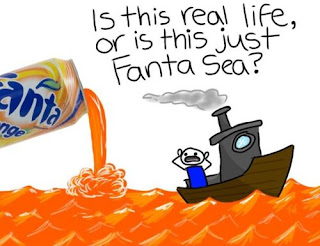Managing time is a
must-do when your life is busy or chaotic, but what about the not so busy? It’s
also important to keep track of important dates and happenings even if you’re
not always on the go, especially if they don’t come as often – you may forget! Google
Calendar is a handy calendar application that is available to those who create
a Google account. It is an interactive agenda that showcases many neat
features, which set it apart from any paper agenda that one could have. Google
Calendar is a useful, professional, and efficient digital media artifact that
can be used by many people who lead a variety of lifestyles.
What makes Google
Calendar a digital media artifact? Google calendar is a digital media artifact
because it was created with and used within the computer. The calendar is kept on
Google’s servers, accessible from any compatible device. Since Google Calendar
is used within this technology, it qualifies as a digital media artifact (Manovich
19).
The interface is very straightforward,
making it simple to use and easy to learn. The layout of Google Calendar is
changeable, depending on how the user wishes to view it. There is a navigation
bar located above the main calendar that allows you to change the view of your
calendar to day, week, month, two weeks, or agenda. There is also a sidebar on
the left that allows for quick calendar navigation, event creation, calendar
sharing, and the ability to select which calendars will be visible. Calendar
sharing is useful because when a calendar is shared with you, it gives you the
ability to see what that person has planned. With this, you can view others’
calendars and overlay them with your own, depending on which are selected at
the time. This allows you to check for possible conflicts in time or allows you
to see when the best available time for another person is.
Another of its
features is the ability to send event invites to other Gmail users, allowing
instant and organized feedback on who will or will not be attending certain
meetings, events, etc. Within the events, the organizer can choose to add more
details such as a location and a description of the event and the responder can
send short messages along with their response. Google Calendar releases the
Christmas spirit within us all. Yes, that is true.
The calendar is
based out of and was created by the Google Incorporation in April of 2006. It
was intended for the use of the public to organize and create events in users’
lives in a more efficient manner. Today, Google Calendar is used just for that
– an easy way to manage one’s time and events occurring throughout their days,
weeks, months, and years. Personally, I use Google Calendar to keep track of my
classes and meetings, as well as manage my time for studying and social
purposes. These are precisely the reasons that it was created, and I use it for
its intended use. I cannot think of a way to use Google Calendar that would be
in a way that it was not intended to be used. While writing this post, I
received an email from my professor about the Spanish conversation hour that
will be taking place this week. It was effortless for me to add an event to my
calendar, now easily visible to me in a time/day grid that also shows my other
obligations.
Google Calendar is
meant for those who have access to the to the interwebz and who have a need for
organization of their schedules and particularly those who already have Google
accounts. Such as me and wedding planners and flower shops and doctors and any
appointment based profession and students especially students and professors it
is nice to arrange meetings of student organizations through Google Calendar. However,
it does not reach the entirety of its target audience, as there are many people
who have Google accounts but do not use Google Calendar.
A disadvantage of
Google Calendar is that you cannot carry your calendar with you if you do not
have a device that is compatible to do so. Another disadvantage is that your
calendar is only accessible by internet access. If you need to access your calendar
and you cannot connect to the internet, then you are fresh out of luck. But
these are downsides that come with most, if not all, digital media.
Overall, Google
Calendar is an exceptional digital media artifact. If Indiana Jones were
searching for digital media artifacts rather than historical, Google Calendar
would be his best find yet.
